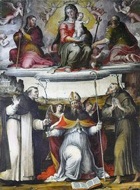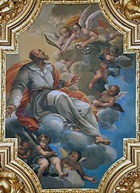

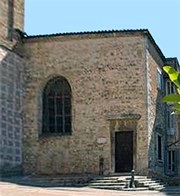
The Oratorio di Sant’ Agostino, which is to the right of the church of Sant' Agostino, belonged to the Confraternita di Sant’ Agostino. A copy (17th century) of the document of 1317 that records the formation of this confraternity survives. An original document of 1325 records the contributions made by its members for the foundation of the adjacent hospice. The complex was rebuilt in the 16th century.
The Confraternita di Sant’ Agostino had close links throughout its history with the Confraternita di San Domenico (first documented in 1318) and the Confraternita di San Francesco (first documented in 1320). The city statute of 1320 relating to the procession on the feast of St Herculanus listed all three among the confraternities taking part. Like other confraternities in the city, all three were engaged in charitable activities, which included the care of the sick, the support of the poor, and the assistance of pilgrims, and they also took part in the civic and religious processions held in the city.
Although the three confraternities were closely associated, each had its own administrative structure and its own oratory. They adopted a common constitution from at least 1472, and this was reformed on a number of occasions from 1520 until 1824. The constitution of 1472 is entitled: “Liber Fraternitatis Domini Nostri Yhesu Christi generalis videlicet Sancti Agostini Sancti Francisci & Sancti Dominici” (Book of the Fraternity of Our Lord Jesus Christ, generally known as SS Agostino, Francesco e Domenico). The preamble to the reformed version of 1824 explains that the three confraternities had been among the numerous associations known as Disciplinati di Gesù Cristo that had been inspired by Raniero Fasani in ca. 1260.
The three confraternities consistently opposed episcopal interference in their affairs, and secured the explicit confirmation of their independence from Pope Urban VIII in 1632. They were suppressed during the French occupation (in 1799-1800 and in 1809-14) but continued to play a prominent role in the city thereafter. For example, they distributed funds to the patriots who suffered in the papal invasion of Perugia on 20th June 1859. The three confraternities were united as the Sodalizio Braccio Fortebraccio. in 1904.
Visits can be arranged with the Sodalizio Braccio Fortebracci (tel: 075 5724815)
Oratory
The small Renaissance portal leads to vestibule, which contains frescoes (1762) by Francesco Appiani.
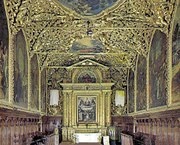
The entrance to the left leads to the oratory, which was remodelled in the Baroque style in the late 16th century. The altar (1586) was designed by Bino Sozi. The fine, gilded ceiling (1698) is by Charles d' Amuelle and Monsù Filippo.
Madonna and Child with Saints (1563)
-
✴the Madonna and Child with SS James and Philip, above; and
-
✴SS Dominic, Augustine and Francis, below.
Scenes from the lives of Christ and of SS Philip and James (1618-30)
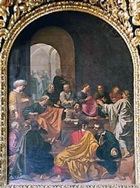
Scenes from the life of St Philip (1656)
The last three panels, which complete the cycle above, are by Bernardino Gagliardi.
Panels by Mattia Batini (1700)
-
✴St Philip (illustrated here);
-
✴St James; and
-
✴St Augustine.
Panels (ca. 1700) of SS Sebastian and Roch to the sides of the window are attributed to him.
Sacristy (1762)
Madonna and Child with Saints (1625)
The Perugian confraternities dedicated to SS Dominic, Francis and Augustine commissioned this processional banner from Giovanni Antonio Scaramuccia in 1625. It depicts the Madonna and Child with SS Dominic, Augustine and Francis. It now forms the altarpiece of the altar in the sacristy.
Scenes from the Life of St Augustine (1762)

Hospice (early 14th century)
The entrance in the right wall of the oratory leads to the subterranean hospice that the confraternity administered.
Crucifixion (14th century)
This fresco, which is one of a number that survive from the original decoration, is attributed to the Maestro di Paciano.
Crucifixion (early 16th century)
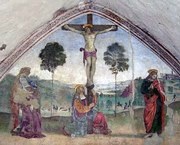
This fresco on what was the altar wall, which was rediscovered in 1991, depicts the Crucifixion with the Virgin and St John the Evangelist and the kneeling St Mary Magdalene. It was initially attributed to the young Raphael, but is now attributed to Berto di Giovanni, Sinibaldo Ibi and/or Lattanzio di Giovanni (see below).
Frescoes (early 16th century)
These frescoes of the heads of SS Francis and Dominic, which were recently uncovered on on what was the altar wall, have been attributed to Lattanzio di Giovanni, who was a member of the Confraternita di Sant’ Agostino. (An altarpiece (1510) by Berto di Giovanni and Sinibaldo Ibi, who were close colleagues of Lattanzio di Giovanni, originally stood on the altar in front of these frescoes - see below).
Art from the Oratory
Gonfalone di Sant'Agostino (1499)
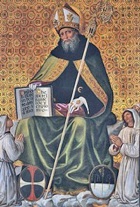
The banner depicts St Augustine enthroned with three kneeling figures of members of the flagellant confraternity.
Madonna and Child enthroned with saints (1510)
The Confraternita di Sant’ Agostino commissioned this altarpiece, which is dated by inscription, from Berto di Giovanni and Sinibaldo Ibi for the oratory. The altarpiece, which depicts the Madonna and Child enthroned with SS Augustine and Sebastian, was moved to the sacristy, possibly when the oratory was remodelled in the 17th century. The confraternity gave it to the Galleria Nazionale in 1872.
Virtues (17th century)
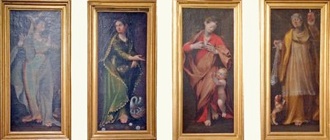
These panels from the oratory, which are attributed to Simeone Ciburri, depict:
-
✴the Theological Virtues, Faith, Hope and Charity; and
-
✴the virtue of Mercy (Clemenza).
They are now in the the Galleria Nazionale.
Read more:
G. Casagrande, “Penitenti e Disciplinati a Perugia e loro Rapporti con gli Ordini Mendicanti”, Mélanges de l' Ecole Francaise de Rome", 89 (1977) 431-44
Two relevant articles appear in:
“Il Movimento dei Disciplinati nel Settimo Centenario dal suo Inizio: Atti del Convegno Internazionale”, (1962) Perugia:
E. Ardu, “Documenti Attinenti alle Confraternite Perugine dei Disciplinati”, pp 519-55
R. Gûeze, “Le Confraternite di S. Agostino, S. Francesco e S. Domenico di Perugia”, pp 597-623
See also: Other Hospices and Hospitals of Perugia and
Return to Monuments of Perugia.
Return to Walk V.
